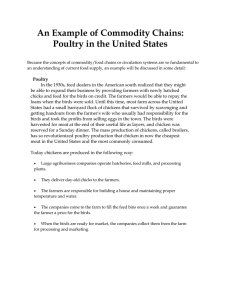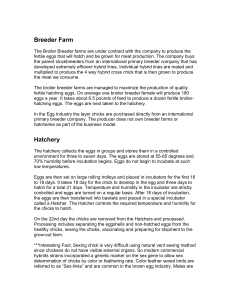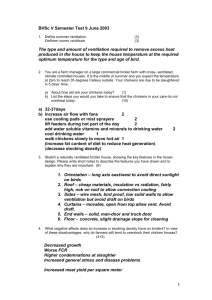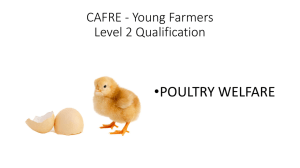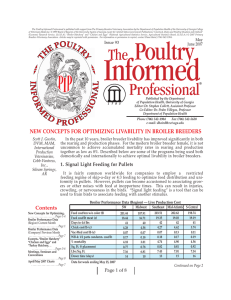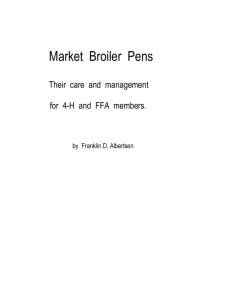Raising Your Own Meat Flock
advertisement
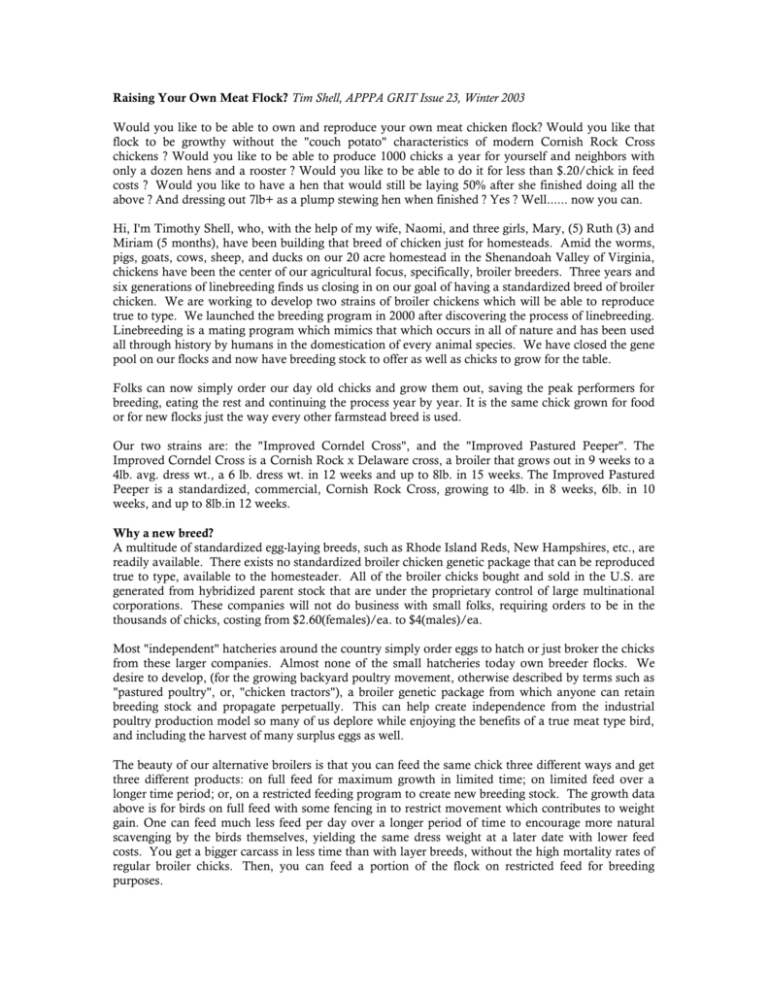
Raising Your Own Meat Flock? Tim Shell, APPPA GRIT Issue 23, Winter 2003 Would you like to be able to own and reproduce your own meat chicken flock? Would you like that flock to be growthy without the "couch potato" characteristics of modern Cornish Rock Cross chickens ? Would you like to be able to produce 1000 chicks a year for yourself and neighbors with only a dozen hens and a rooster ? Would you like to be able to do it for less than $.20/chick in feed costs ? Would you like to have a hen that would still be laying 50% after she finished doing all the above ? And dressing out 7lb+ as a plump stewing hen when finished ? Yes ? Well...... now you can. Hi, I'm Timothy Shell, who, with the help of my wife, Naomi, and three girls, Mary, (5) Ruth (3) and Miriam (5 months), have been building that breed of chicken just for homesteads. Amid the worms, pigs, goats, cows, sheep, and ducks on our 20 acre homestead in the Shenandoah Valley of Virginia, chickens have been the center of our agricultural focus, specifically, broiler breeders. Three years and six generations of linebreeding finds us closing in on our goal of having a standardized breed of broiler chicken. We are working to develop two strains of broiler chickens which will be able to reproduce true to type. We launched the breeding program in 2000 after discovering the process of linebreeding. Linebreeding is a mating program which mimics that which occurs in all of nature and has been used all through history by humans in the domestication of every animal species. We have closed the gene pool on our flocks and now have breeding stock to offer as well as chicks to grow for the table. Folks can now simply order our day old chicks and grow them out, saving the peak performers for breeding, eating the rest and continuing the process year by year. It is the same chick grown for food or for new flocks just the way every other farmstead breed is used. Our two strains are: the "Improved Corndel Cross", and the "Improved Pastured Peeper". The Improved Corndel Cross is a Cornish Rock x Delaware cross, a broiler that grows out in 9 weeks to a 4lb. avg. dress wt., a 6 lb. dress wt. in 12 weeks and up to 8lb. in 15 weeks. The Improved Pastured Peeper is a standardized, commercial, Cornish Rock Cross, growing to 4lb. in 8 weeks, 6lb. in 10 weeks, and up to 8lb.in 12 weeks. Why a new breed? A multitude of standardized egg-laying breeds, such as Rhode Island Reds, New Hampshires, etc., are readily available. There exists no standardized broiler chicken genetic package that can be reproduced true to type, available to the homesteader. All of the broiler chicks bought and sold in the U.S. are generated from hybridized parent stock that are under the proprietary control of large multinational corporations. These companies will not do business with small folks, requiring orders to be in the thousands of chicks, costing from $2.60(females)/ea. to $4(males)/ea. Most "independent" hatcheries around the country simply order eggs to hatch or just broker the chicks from these larger companies. Almost none of the small hatcheries today own breeder flocks. We desire to develop, (for the growing backyard poultry movement, otherwise described by terms such as "pastured poultry", or, "chicken tractors"), a broiler genetic package from which anyone can retain breeding stock and propagate perpetually. This can help create independence from the industrial poultry production model so many of us deplore while enjoying the benefits of a true meat type bird, and including the harvest of many surplus eggs as well. The beauty of our alternative broilers is that you can feed the same chick three different ways and get three different products: on full feed for maximum growth in limited time; on limited feed over a longer time period; or, on a restricted feeding program to create new breeding stock. The growth data above is for birds on full feed with some fencing in to restrict movement which contributes to weight gain. One can feed much less feed per day over a longer period of time to encourage more natural scavenging by the birds themselves, yielding the same dress weight at a later date with lower feed costs. You get a bigger carcass in less time than with layer breeds, without the high mortality rates of regular broiler chicks. Then, you can feed a portion of the flock on restricted feed for breeding purposes. Why two strains? Our first thought was that by free ranging the parent stock on pasture we could get a hardier broiler chick. Growing modern Cornish Rock chicks is like growing plants in a greenhouse, they are a "hot house" species that has to be gradually hardened off to the outdoor environment, just like a green house plant. This hardening off process yields up to 10% mortality in the shift from brooder to field conditions and up to another 5% in the field from heart attacks and ascites, a chronic heart failure disease. Most folks familiar with raising laying hens from day old stock are disgusted with the fragility and laziness of the commercial Cornish Rock in comparison. Most major producers now simply factor the mortality in as a cost of doing business. Our Pastured Peepers show a 10 to 20% improvement over the commercial birds, which is good, but we were looking for an 80 to 90% improvement. The Pastured Peeper is a good bird for large pastured broiler operations, such a Joel Salatin's Polyface Inc., which uses them. We initiated the Corndel Cross using the Delaware, a heritage breed used in the mid 1900's for broiler production. The Corndel Cross is a 25% Delaware x 75% Cornish Rock Cross. These chicks show a 40 to 60% improvement over the commercial birds but do take a week longer to grow out. The improvement is mainly seen in their ability to handle more weather-related stress in field conditions, such as extremes of cold, heat and moisture. The Corndel is a busier bird, a much better forager without the characteristic feet and leg trouble seen in the Cornish Cross. They tend to range further afield, covering more territory acquiring food. They still retain the Cornish Cross benefits of great feed conversion, the large, plump, double breast and the white feathering for a clean looking, dressed carcass. Flavor is much improved. These hyperactive, pasture-hardy chicks are much more fun to raise, especially for young children who can be so easily disillusioned with death among the flock. The Corndel performs well in pasture pens/chicken tractors but really shines in the "day range" model using electrified poultry netting, since they are willing to move around much more. How do you grow breeders ? Broiler breeders of any type must be grown out on a restricted feed program. This program is designed to grow the chick slowly to maturity rather than as fast as possible. If a full feed program is used the hens will develop so much fat around the reproductive organs, especially the egg canal, that they will prolapse their rectum when attempting to lay their first egg. The males will be clumsy and heavy, struggling to mount and breed the hens, falling off when mounted, and producing excessive wear and stress on the hen and even lacerations of the saddle. Amazingly, on a properly controlled diet, instead of looking ridiculously obese, waddling like a duck, etc., these birds are just like a normal egg laying breed; aggressive, lithe and agile, able to run, fly and roost in trees (or on your tractor seat), dig out your wife's flower bed, etc. Yes, the roosters can and will "flop" you. How funny trying to imagine a normal broiler doing that! To grow breeders you need a feed chart, which designates the appropriate amount of feed to be given for each week of age of the birds life. It is a very challenging program to learn. Even though the birds on the program are in excellent health and act just like a normal chicken, they still have the ravenous appetite of a broiler. They truly believe they are starving. This can create a problem, being stampeded with hungry birds every day at feeding time, and preparations must be made in advance for correct housing and control of the birds. It is easy to overfeed them, creating trouble later. We have developed a model that gives optimum control using a permanent shelter and paddocks rotated around it made with electrified poultry netting. Thus it is now possible for anyone to maintain a breeding flock that has most of the advantages of a meat type bird and less of the drawbacks. In Virginia, a broiler breeder hen will produce about 100 chicks over a 28 week period from March through September, with optimum management. Eggs can be set once a week The birds need about .33 to .36lb of feed/day when laying, so they eat a little more than a regular layer but the eggs are very large, yielding large chicks. The stewing hens when finished are enormous, over 7lb dressed. The breeders can be used for two years, but it is more practical to renew them every year. To use them a second year a slim-down process must be enforced after the first cycle of laying to prevent over conditioning; this is difficult to do. It is 24 weeks from the time a baby broiler breeder hen hatches out to the laying of her first egg. Two generations can be produced in one year. A male can service about 10 to 12 hens. So, with a dozen birds you could produce up to 1000 chicks in a season, or about 30 to 35 a week. Or, you could set every other week, using eggs on odd weeks for table use if only 500 chicks are desired. These dozen birds will produce at this rate on under 5lb of feed per day, or about 1000lb for the production season. It takes about 20lb to get each bird from day old to first egg, 240lb for the 12 bird flock. At $.13/lb feed x 1240lb = $161.2 or $.16/chick in feed costs. That leaves a lot of room to account for a return to labor. They will still be laying about 50% at the end of 28 weeks of chick production. The flock can be dressed for stewing or allowed to continue into winter producing table eggs once the season for growing and processing broilers is over. To choose breeding stock, simply harvest all birds with undesirable characteristics, (color, small size, disease, etc) and mate the best with the best. This will continue the standardizing process, allowing you to set your own criteria and generate a population whose performance is adapted to your specific production model and environment. The longer you take to grow birds the healthier they will be. [I grow breeders out to the same live weight (6lbs) in 24 weeks that broilers grow to in 8 weeks. They act just like normal chickens except that they believe they are on the verge of starvation 24/7. ] You only need to cut back on the feed a little along the way to do this. Of course, you also need enough feeder space for all to eat at once so the smaller ones don't get pushed back. I know this is a lot more attention to detail than most folks are willing to put forth. It is a lot easier to just keep the feed trough full. That is why alternative breeds of broilers will probably stay in the market for the near future. For further information contact: Timothy Shell 407 Mt. Solon Rd. Mt. Solon, VA 22843 540-885-4965 tshell@firstva.com
